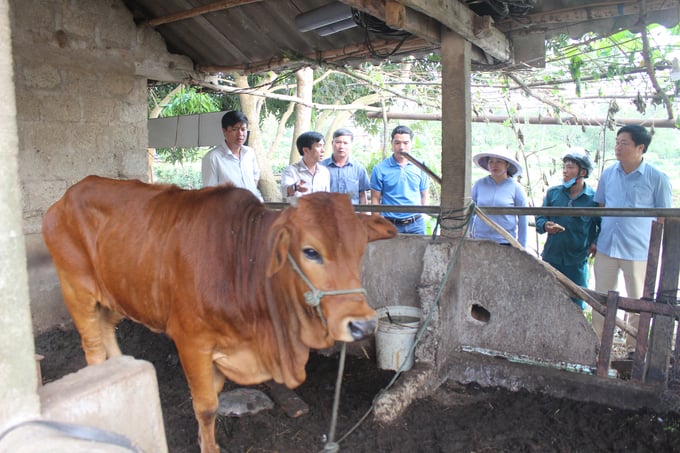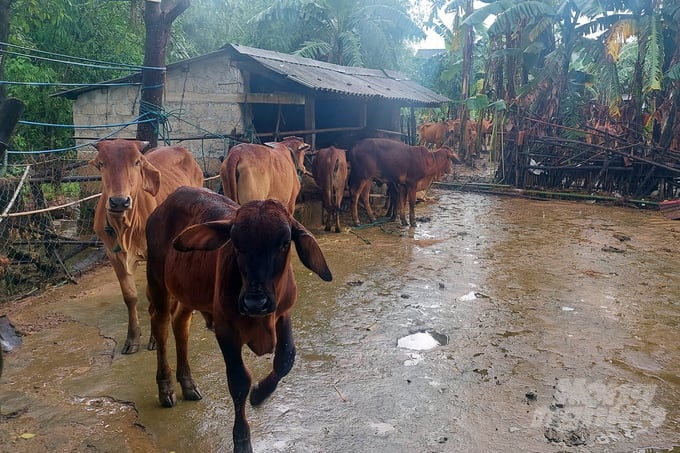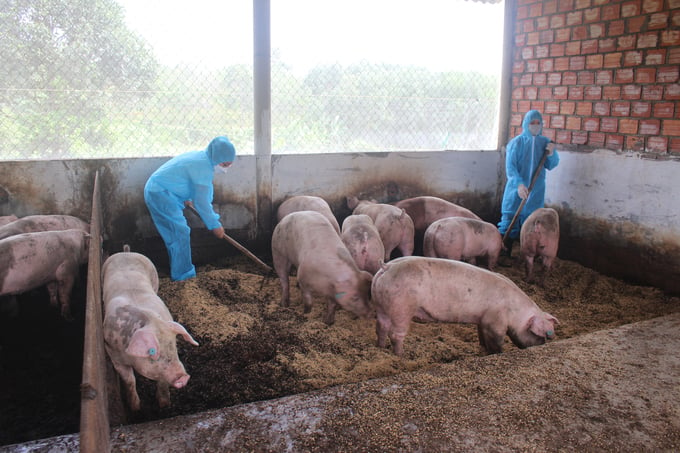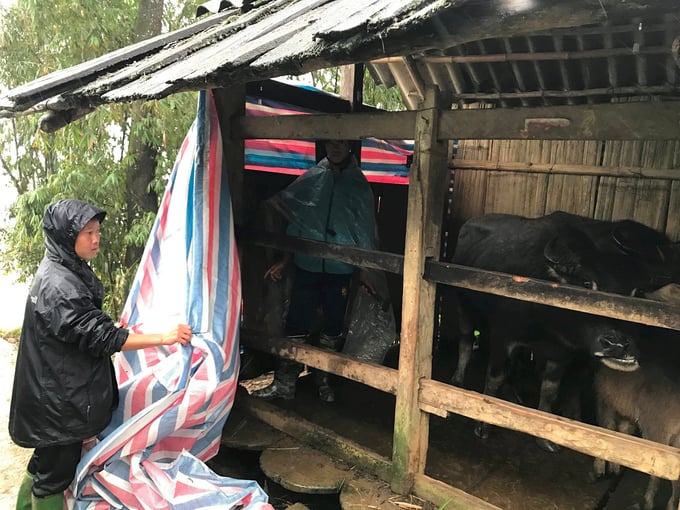Quang Tri Department of Livestock and Veterinary Medicine guides measures to ensure safety for livestock during the rainy and flood season.
According to forecasts of the National Center for Hydrometeorological Forecasting, in 2024, although there will be fewer storms and tropical depressions than the average for many years, the risk of extreme, unusual, and illegal natural disasters will occur and very complicated. Therefore, it is necessary to pay attention to the prevention, care and protection of livestock before, during and after the stormy season.
Recently, the Department of Agriculture and Rural Development of Quang Tri issued a document requesting units and localities in the province to proactively implement measures to ensure safety for livestock during the 2024 rainy and flood season. The Quang Tri Department of Livestock and Veterinary Medicine guides measures to ensure safety for livestock during the rainy and flood season with the following solutions:

Quang Tri specialized industry inspects livestock barns before the rainy season. Photo: Viet Toan.
Before the rainy season
Regularly update weather forecasts on central and local mass media, actively take care of livestock to increase resistance to major changes in weather, rain as well as Prepare effective solutions and solutions when storms, floods or epidemics occur afterward. Statistics and declaration of number and type of livestock according to regulations.
For areas at risk of flooding:
Do not build livestock barns near river banks, stream banks, or high slopes to avoid floods, flash floods, and landslides. Actively raise the floor of the barn, build a barn to avoid floods, and make curtains to avoid rain and drafts.
Carry out inspections and firmly reinforce barns to prevent storms and floods. If the barn is roofed with leaves, corrugated iron, or unstable cement fiber, the roof can be braced with wooden, iron, large-sized wire or sandbags and water cans to limit the roof from blowing off when the wind blows, storm occurs.
Feed: Make a raised floor, nylon cloth to cover the rain. Based on the number, type of livestock, and amount of food consumed per day by the livestock facility, plan to reserve adequate food for at least 15 days for livestock.
Check and clear the drainage system of the barn area such as wastewater drainage system, rainwater drainage system, solid waste storage area to limit pollution during heavy rain or flooding.
Drinking water: Reserve clean water, repair pumps and water systems to ensure timely backup supply.
Professional staff guide livestock households to take measures to care for livestock during the rainy season. Photo: Viet Toan.
For flooded areas:
Prepare a plan to move livestock to high ground by carefully building shelters, storing enough food and keeping the food dry, not moldy, and providing enough clean water for livestock. Use backup generators to provide timely power supply to breeding incubators when there is a power outage to ensure there are quality breeds to regenerate.
Fully vaccinate livestock against diseases according to the instructions of local veterinary staff, ensuring the vaccination rate reaches over 80% of the total herd present at the time of vaccination. Enhance care, nourishment and improve the quality of animal diets to increase resistance.
Count and evaluate the current status of livestock and sell them promptly when they reach age or the volume for sale. Check the operation of livestock waste treatment systems such as compost pits, sedimentation tanks, and biogas plants. Strengthen hygiene and disease prevention for livestock, clean cages and livestock tools; Periodically spray disinfectant inside and outside the barn to prevent disease.
During and after storms and floods
During storms and floods:
Regularly check and monitor the weather, check barns, livestock conditions and livestock health to have plans for care, support and relocation if necessary.
Relocate livestock to a location that is not flooded by means of transport such as boats, canoes, rafts, etc. but must absolutely ensure human life and livestock health.
Do not gather or build animal shelters on dikes or roads, causing traffic obstruction and environmental pollution.
Make temporary houses for animals: Set up tents, tents and have a plan to control animals. There are solutions to keep livestock warm in prolonged cold and rainy weather conditions.
Livestock face many risks of hunger, cold, and disease during the rainy season. Photo: NNVN.
Disease prevention work:
+ Floods cause pathogens to spread everywhere with flood water. The larger and wider the flood, the greater the spread of pathogens and the higher the risk level. On the other hand, when moving livestock to avoid floods, they will carry pathogens from one place to another. Care, feeding, and cleaning and disinfection of barns that are not done well will significantly reduce disease resistance in livestock, making infectious diseases such as diarrhea, cholera, typhoid, etc. more likely to spread and risk of outbreak.
+ Regularly clean the barn, the barn environment and livestock equipment. Periodically, 1-2 times a week, spray and disinfect the barn and surrounding area with disinfectants according to regulations and according to the manufacturer’s instructions. When the water recedes, clean up, spray disinfectant, detoxify, and kill pathogens.
+ For animals. that need to be transported from one place to another, it is necessary to properly carry out transportation and quarantine procedures (if any) to ensure disease safety.
+ For dead animal carcasses: The most effective treatment is to burn the carcass (if possible), spray insecticide or antiseptic or pour kerosene on the carcass to prevent predators and insects invade, wait until the water recedes then bury it according to the instructions of a specialized agency.
After storms and floods:
Food and water: After a flood, sources of food and water for livestock and poultry can be swept away and damaged by floods, pastures are polluted by pathogens from other places, and mud and dirt can stick to grass and trees, the health of livestock declines. Therefore, pets need to be carefully cared for and nurtured, not starved, not fed moldy or poor quality food, and not allowed to drink contaminated water.
For old and weak cattle, special care is needed such as providing additional feed and other nutritious foods to enhance the recovery process.
Environmental hygiene: When the water recedes, it is necessary to clean and disinfect with lime powder, chemicals and disinfect the livestock area before returning animals to the barn. Authorities and specialized agencies at all levels organize general cleaning and collection of dead animal carcasses to treat, disinfect and disinfect flooded livestock areas to thoroughly disinfect the environment and destroy pathogens.
It is necessary to cover the barn carefully during the rainy season. Photo: NNVN.
Animal management:
+ Implement well the management and care of livestock; Absolutely do not graze livestock in polluted areas; Proactively deploy surveillance work to detect early and promptly handle cases of livestock that are sick or suspected of having dangerous diseases such as: African swine fever, bird flu, foot-and-mouth disease, and raised dermatitis lumps in cattle, blue ears in pigs, etc.
Propagate and guide pet owners to immediately report to local authorities and veterinary agencies to investigate and handle outbreaks according to regulations; Do not slaughter, buy and sell sick or dead animals, and do not throw dead animals due to disease into the environment.
Increase officials to the villages and communes along with the grassroots veterinary force to inspect livestock facilities to guide people in burying and destroying livestock and poultry that died due to floods. Organize cleaning of cages, spray disinfection in low-lying areas, prolonged flooding, high-risk areas, etc. At the same time, continue to implement periodic vaccination or full supplementary vaccination of all types of vaccines for herds. livestock to villages, hamlets, and livestock households according to the instructions of local veterinary staff, ensuring the vaccination rate reaches over 80% of the total herd present at the time of vaccination.
Restocking: To prepare for restocking and restoring livestock, farmers need to choose breeds of clear origin, provided by reputable establishments, with quarantine certificates, and fully vaccinated. All types of vaccines as prescribed. Do not re-herd without ensuring environmental and disease safety.
Policy implementation: Have a plan to support breeds, chemicals for environmental treatment, and destroy livestock that die due to floods and epidemics. Summarize the number of types of livestock damaged, report on difficulties and obstacles in overcoming the consequences of rain and floods and in the work of preventing and fighting animal diseases in the area. There are written reports and proposals for consideration and support to overcome consequences according to regulations, including support for disinfectant chemicals and disease prevention and control.
Phan Viet Toan



